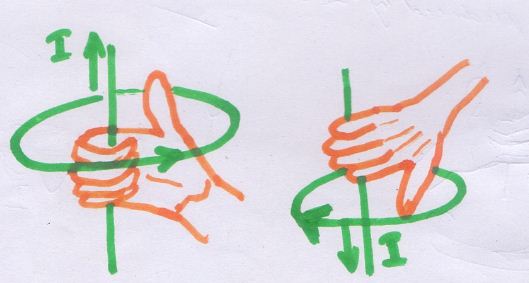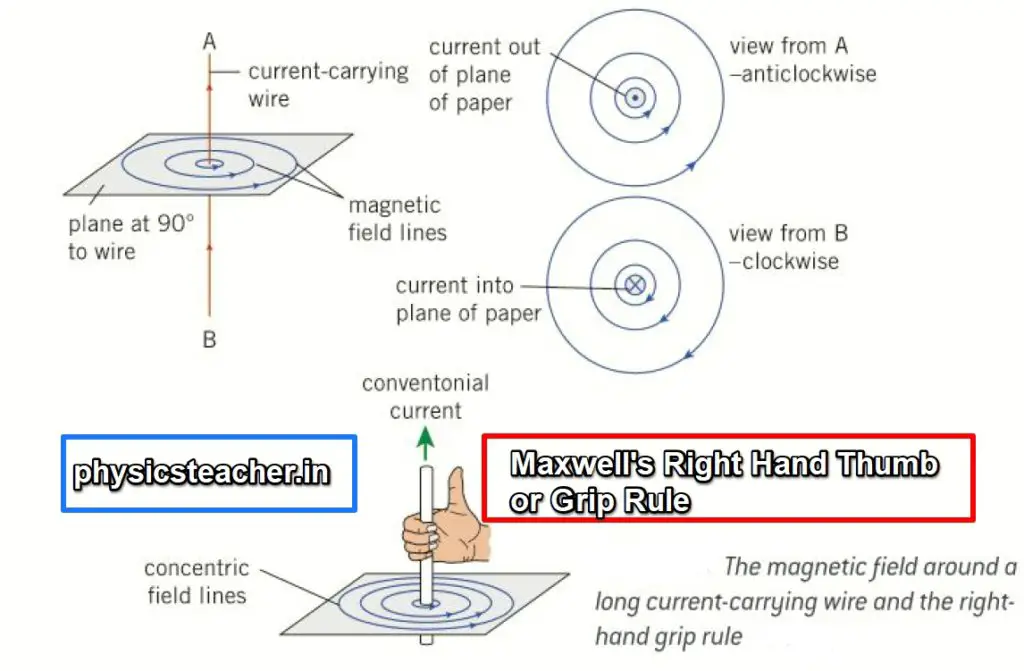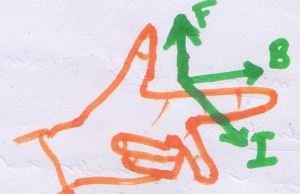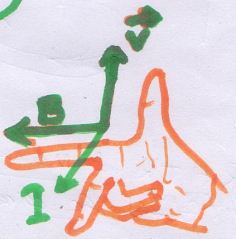Electromagnetism: Fleming’s Left hand Rule, Right Hand Rule, Maxwell’s Right hand thumb/grip rule with statements and uses
Last updated on October 6th, 2021 at 04:35 pm
Let’s find out a few interesting incidents of electromagnetism and in the process let’s discuss a few physics Laws or rules like Maxwell’s Right-hand thumb rule or Right-hand grip rule of Maxwell, Fleming’s Left-hand rule, and Fleming’s Right-hand rule and their uses and statements. We also figure out motor law and dynamo law (or generator law). We have also listed down the major differences between Fleming’s left-hand rule and right-hand rule.
This tutorial will benefit the students of class 10 and class 12 who have physics in their curriculum.
- Electromagnetic Interaction Events & Physics Rules Used
- Magnetic Field created by a straight current-carrying conductor & its direction
- Effect of an External Magnetic Field on a Current-Carrying Conductor
- Effect of a Magnetic Field on a moving Conductor
- Difference between Fleming's left and right-hand rule
- Summary | Quick Take Away
Electromagnetic Interaction Events & Physics Rules Used
Electromagnetic Force manifests itself in 2 forms, Electricity, and Magnetism. Electromagnetism is a branch of physics that describes the interactions of electricity and magnetism. A magnetic field is created by moving charges i.e. electric current. Again a magnetic field can induce the movement of charges (electric current).
Magnetic Field and a conductor (maybe current-carrying or not carrying, may be static or moving) can have different mutual effects in different scenarios, based on some specific conditions. Let’s list down a few such incidents of electromagnetism and the rules defining these incidents.
| Electromagnetic Interaction Event | electromagnetism | Physics Rule Involved | The functionality of the Rule |
|---|---|---|
| Magnetic Field created by a straight current-carrying conductor | RIGHT-HAND THUMB RULE of Maxwell | The direction of the magnetic field created due to the current flow can be found using the RIGHT-HAND THUMB RULE of Maxwell (or Right-Hand grip rule) |
| Effect of an External Magnetic Field on a Current-Carrying Conductor | Fleming’s Left-hand rule | Fleming’s Left-hand rule helps us to find out the direction of the force experienced by the current-carrying conductor placed in a magnetic field that is perpendicular to the direction of the current flow in the wire. Explains Motor effect |
| Effect of a Magnetic Field on a moving Conductor | Fleming’s Right-Hand Rule | Fleming’s Right-hand rule helps us to find out the direction of the induced current in the moving conductor placed in a magnetic field that is perpendicular to the direction of the movement of the just mentioned conductor. Explains Generator effect |
Magnetic Field created by a straight current-carrying conductor & its direction
The magnetic effect of electric current can also be easily shown by placing a magnetic compass near a wire which is carrying electric current. We see that the needle of the compass is deflecting, which proves that a magnetic field is produced near the wire.
For a current-carrying wire, the magnetic field lines are concentric circles centered on the wire and perpendicular to it.
If we consider a straight conductor that is carrying current, then the direction of the magnetic field created due to the current flow can be found using the RIGHT-HAND THUMB RULE or right-hand grip rule of Maxwell.
Use of RIGHT HAND THUMB RULE of Maxwell
Maxwell is known as the right-hand thumb rule founder. The RIGHT-HAND THUMB RULE of Maxwell helps to find the direction of the magnetic field produced by a straight current-carrying conductor. Here the cause is the current that flows through a straight conductor and the result is the creation of a magnetic field.

In the diagrams above, I is pointing towards the direction of the current. The Circle with an arrow direction-pointer indicates the direction of the magnetic fields.
Right Hand Thumb Rule of Maxwell | Right Hand grip Rule
The RIGHT-HAND THUMB RULE of Maxwell (or RIGHT-HAND GRIP Rule) states, if we imagine holding a straight current-carrying wire in the right hand, with the thumb stretched along the direction of the current, then the direction in which the other fingers are curled will point the direction of the magnetic field created by the current-carrying conductor. This is also known as the RIGHT-HAND GRIP Rule.

The setup described in the above statement tells us how the right-hand thumb rule helps to determine the direction of the magnetic field created by a current-carrying conductor.
Effect of an External Magnetic Field on a Current-Carrying Conductor
In this case, a magnetic field is already present and a current-carrying conductor is brought into the magnetic field.
Cause and Effect: In other words, here cause is the magnetic field already present and the result is observed in the current-carrying conductor. And the result or effect is a force generated which acts on the current-carrying conductor and deflects it.
An experimental setup can be prepared using a horseshoe magnet (or any other type of magnet) and a thick copper wire connected to a battery via a switch. Here we can find that the current-carrying conductor wire deflects due to a force generated by the magnetic field of the magnet present nearby.
Use of Fleming’s Left Hand Rule | Application
This rule called ‘Fleming’s Left-hand rule’, helps us to find out the direction of the force experienced by the current-carrying conductor placed in a magnetic field that is perpendicular to the direction of the current flow in the wire. This rule helps to understand and explain the motor effect.
(Note this: it’s applicable only if the conductor is placed at the right angle (perpendicular) with respect to the direction of the magnetic field present.)

In the diagram above, B, I, and F are pointing towards the directions of the magnetic field, Current through the conductor, and the force experienced by the conductor RESPECTIVELY.
Left Hand Rule of Fleming | Fleming’s Left-Hand Rule
Fleming’s Left-Hand Rule states that, If the forefinger, second finger, and thumb of the left hand are stretched at right angles to each other, with the forefinger in the direction of the magnetic field, and the second finger in the direction of the current, then the thumb indicates the direction of the force acting on the current-carrying conductor. This Left-hand Rule is also known as Motor Rule.
Experiment related to this rule – Barlow’s wheel
Effect of a Magnetic Field on a moving Conductor
Now if we modify the previous setup a bit and do the following:
– instead of placing a current-carrying conductor in a magnetic field, we will place just a conductor initially, without any current flowing through it. So just a conductor is what is required to be in the magnetic field and yes, it’s to be placed at a right angle to the direction of the magnetic field present; no need for any battery and switch.
– This time the conductor has to be in motion, i.e. the conductor is not static, and it’s moving in the magnetic field.
So are you getting the difference between this setup with the previous one? The previous one dealt with a conductor which is already carrying a current. When it’s placed in a magnetic field at a right angle, then it would result in a deflection or movement in the conductor.
But in this case, no current needs to flow initially through the conductor. And this time the conductor is given a movement at a right angle to the magnetic field. (This is the setup required)
Do you know what the result is this time?
This setup caused the generation of an electromotive force in the conductor which results in an induced flow of current through the moving conductor.
Cause and Effect: So here cause is the movement of a conductor in a magnetic field at a right angle and the result is the generation of current flow through the moving conductor.
Fleming’s right-hand rule comes in handy here.
Use of Fleming’s Right Hand Rule | Application
This rule called ‘Fleming’s Right-hand rule’, helps us to find out the direction of the induced current in the moving conductor placed in a magnetic field that is perpendicular to the direction of the movement of the just mentioned conductor. This rule helps to understand and explain the Generator effect.

In the diagram above, B indicates the magnetic field, I indicates the induced current and V indicates the movement of the conductor in the magnetic field.
Right Hand Rule of Fleming | Fleming’s Right-Hand Rule
Fleming’s Right Hand Rule states that, If the forefinger, second finger, and thumb of the right hand are stretched at right angles to each other, with the forefinger in the direction of the magnetic field and the thumb in the direction of the movement of the conductor then the second finger will indicate the direction of the current induced in the moving conductor. This Rule is also known as Dynamo or Generator rule.
Difference between Fleming’s left and right-hand rule
Both the rules are contributed by John Fleming. But these 2 rules are different and applicable in different situations. The next table lists the important differences between Fleming’s left-hand and right-hand rules.
| Fleming’s left-hand rule | Fleming’s right-hand rule |
|---|---|
| The left-hand rule explains the Motor effect and is known as the motor rule. | The Right-hand rule explains the Generator effect and is known as the Generator rule. |
| This Left-hand motor rule helps us to find out the direction of the force experienced by the current-carrying conductor placed in a magnetic field that is perpendicular to the direction of the current flow in the wire. | This right-hand generator rule helps us to find out the direction of the induced current in the moving conductor placed in a magnetic field that is perpendicular to the direction of the movement of the just mentioned conductor. |
| The thumb represents the direction of the force experienced by the current-carrying conductor | The thumb represents the direction of motion of the conductor |
| The current in the conductor is pre-existing (not induced) | The current in the conductor is induced due to the generator effect. |
| This left-hand rule is all about the Effect of an External Magnetic Field on a Current-Carrying Conductor | The right-hand rule is about the Effect of a Magnetic Field on a moving Conductor |
Summary | Quick Take Away
| Electromagnetic Interaction Event | Physics Rule Involved | The functionality of the Rule |
|---|---|---|
| Magnetic Field created by a straight current-carrying conductor | RIGHT-HAND THUMB RULE of Maxwell | Determines the direction of the magnetic field created due to the current flow |
| Effect of an External Magnetic Field on a Current-Carrying Conductor | Fleming’s Left-hand rule | Determines the direction of the force experienced by the current-carrying conductor placed in a magnetic field | Also known as Motor Rule |
| Effect of a Magnetic Field on a moving Conductor | Fleming’s Right-Hand Rule | Determines the direction of the induced current in the moving conductor. Also known as Generator Rule |
Read Generator Effect and Motor Effect – underlying Physics principle
A Video on Fleming’s right hand rule (credit: Youtube publisher)
Related Posts:
generator effect and motor effect – principle
Interesting notes:
A magnet produces a magnetic field in the space around it. This field exerts a force on any other magnet placed in that field. Each point in this field has a particular strength (field strength) and a definite direction.
When we keep a magnetic compass in the field of a magnet (say a Bar magnet), the direction of its needle gives the direction of the net magnetic field due to the bar magnet and the earth’s magnetic field. However, if we keep the compass very close to the magnet, the earth’s field may be neglected.
Great! So the generation of the magnetic fields can be credited to a magnet! Now we also know that a magnetic field can also be created by an electric current in a conductor. Danish Physicist H.C. Oersted noted this first in 1820.

